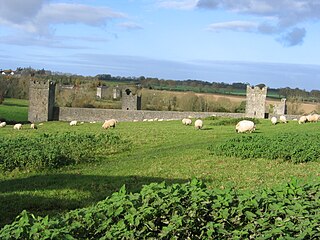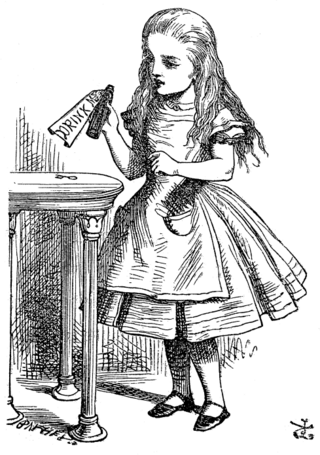| |||||
| Centuries: | |||||
|---|---|---|---|---|---|
| Decades: | |||||
| See also: | Other events of 1280 List of years in Ireland | ||||
This article needs additional citations for verification .(April 2022) |
Events from the year 1280 in Ireland.
| |||||
| Centuries: | |||||
|---|---|---|---|---|---|
| Decades: | |||||
| See also: | Other events of 1280 List of years in Ireland | ||||
This article needs additional citations for verification .(April 2022) |
Events from the year 1280 in Ireland.
| | This section is empty. You can help by adding to it. (July 2010) |
| | This section is empty. You can help by adding to it. (July 2021) |

Flying ointment is a hallucinogenic ointment said to have been used by witches in the practice of European witchcraft from at least as far back as the Early Modern period, when detailed recipes for such preparations were first recorded and when their usage spread to colonial North America.
Dame Alice Kyteler was the first recorded person condemned for witchcraft in Ireland. She fled the country to either England or Flanders, and there is no record of her after her escape from persecution. Her servant Petronilla de Meath was flogged and burned to death at the stake on 3 November 1324, after being tortured and confessing to the heretical crimes she, Kyteler, and Kyteler's followers were alleged to have committed.
Petronilla de Meath was the maidservant of Dame Alice Kyteler, a Hiberno-Norman noblewoman who lived in Ireland in what is now County Kilkenny. After the death of Kyteler's fourth husband, Kyteler was accused of practicing witchcraft and Petronilla was charged with being one of her accomplices. Petronilla was tortured and forced to proclaim that she and Kyteler were guilty of witchcraft. Kyteler fled to save her life, and Petronilla was then flogged and eventually burnt at the stake on 3 November 1324, in Kilkenny. Hers was the first known case in Ireland or Great Britain of death by fire for the crime of heresy.

Kells Priory is one of the largest medieval monuments in Ireland. The Augustine priory is situated alongside King's River beside the village of Kells in the townland of Rathduff (Madden), about 15 km south of the medieval city of Kilkenny. The priory is a National Monument and is in the guardianship of the Office of Public Works. One of its most notable features is a collection of medieval tower houses spaced at intervals along and within walls which enclose a site of just over 3 acres (12,000 m2). These give the priory the appearance more of a fortress than of a place of worship and from them comes its local name of "Seven Castles".

Richard FitzRalph was a scholastic philosopher, theologian, and Norman Irish Archbishop of Armagh during the 14th century. His thought exerted a significant influence on John Wycliffe's.
John D'arcy, 1st Baron D'arcy de Knayth was an English peer. He was created 1st Baron Darcy in 1317.

The name Alice is one of the small names that are really elegant. It is used as a feminine name in many cultures, having roots in the French and Greek languages.

Calverstown is a small village in County Kildare, Ireland. It lies 6 km (3.7 mi) south of the town of Kilcullen and about 16 km (9.9 mi) from each of the towns of Athy, Kildare, Naas and Newbridge. It is an old settlement located close to the archaeological sites of Dún Ailinne and Old Kilcullen. The village has a stream running through it with another to the south. As of the 2016 census, Calverstown had a population of 699.
Events from the year 1324 in Ireland.
Florence Newton was an alleged Irish witch, known as the "Witch of Youghal", who died during what St John Seymour as one of the most important examples of Irish witch trials.

The history of Kilkenny began with an early sixth-century ecclesiastical foundation, this relates to a church built in honour of St. Canice, now St. Canice's Cathedral and was a major monastic centre from at least the eighth century. The Annals of the Four Masters recorded the first reference Cill Chainnigh in 1085. Prehistoric activity has been recorded suggesting intermittent settlement activity in the area in the Mesolithic and Bronze Age. Information on the history of Kilkenny can be found from newspapers, photographs, letters, drawings, manuscripts and archaeology. Kilkenny is documented in manuscripts from the 13th century onwards and one of the most important of these is Liber Primus Kilkenniensis.
Roger Utlagh, or Roger Outlawe was a leading Irish cleric, judge and statesman of the fourteenth century who was Prior of Kilmainham, and held the office of Lord Chancellor of Ireland. He was the brother-in-law of the celebrated Witch of Kilkenny, Alice Kyteler, and is mainly remembered today for his efforts to shield her from prosecution, and subsequently enabling her to escape punishment, during the Kilkenny Witch Trials of 1324.
Walter de Islip, Isleep or de Istlep was an English-born cleric, statesman, and judge in fourteenth-century Ireland. He was the first Chief Baron of the Irish Exchequer; he also held the offices of Treasurer of Ireland, Chief Escheator, and Custos Rotulorum of Kilkenny. He was a noted pluralist, who held numerous benefices. His career was seriously damaged by accusations of corruption and maladministration. He played an important role in the celebrated Kilkenny Witchcraft Trials of 1324.
William de Rodyard, de Rodiard, or de Rudyard was an English-born judge and cleric in fourteenth-century Ireland. He held office as Chief Justice of the Irish Common Pleas. He was also Dean of St Patrick's Cathedral, and briefly Deputy Lord Treasurer of Ireland. He was the first Chancellor of the Medieval University of Dublin.
Richard de Ledrede, also known as Richard Ledred, was a 14th-century churchman in Ireland who served as Bishop of Ossory. His long tenure as Bishop was marked by bitter controversies and repeated quarrels with his colleagues, both lay and clerical.

Kyteler's Inn is a public house located in the centre of medieval Kilkenny in Ireland.
Witch trials and witch related accusations were at a high during the early modern period in Britain, a time that spanned from the beginning of the 16th century to the end of the 18th century.
Events from the year 1302 in Ireland.
John de Ponz, also called John de Ponte, John Savan, or John of Bridgwater (c.1248–1307) was an English-born administrator, lawyer and judge in the reign of King Edward I. He served in the Royal Household in England for several years before moving to Ireland, where he practised in the Royal Courts as the King's Serjeant-at-law (Ireland). He later served as a justice in eyre, and then as a justice of the Court of Common Pleas (Ireland). He was a gifted lawyer, but as a judge was accused of acting unjustly. A case he heard in Kilkenny in 1302 can be seen as a precursor of the Kilkenny Witchcraft Trials of 1324, and involved several of the main actors in the Trials.